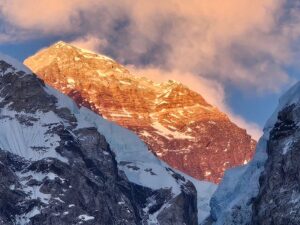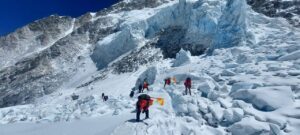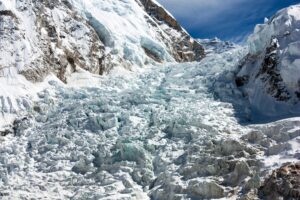Besides creating a nonstop drone, helicopters are also commonly used in both insurance and climbing fraud.
In yesterday’s piece on helicopters in Nepal’s Himalaya, we considered the issues around their use, their overuse, and their misuse. Today, we venture deeper into those muddy waters.
The most heated aspect of this debate is not about the aesthetics of taking tourists for a spin around the mountains at the cost of a near-constant drone. It’s about the false rescues, and the climbers (?) who want to shortcut their way to the summit. Finally, we look at Nepal’s new regulations to prevent both problems.
For years, insurance companies have noted casual use of helicopter “rescues” in the Himalaya. In contrast with Pakistan, where the helicopters (they always fly in pairs for military safety reasons) do not take off until the charter cost has been deposited, companies in Nepal are usually fine with sending allegedly sick clients back to Kathmandu. They categorize it as a rescue airlift and charge the flight (and sometimes also the fat medical bills) to the insurance companies.
The evacuees are then left at the airport, either to go a doctor or to their hotels, if the injuries are not serious. This way, the client gets a free airlift and the operators — well, they may or may not benefit. The ones with connections to helicopter companies inarguably do.
Nepal has been trying to cut out this malpractice ever since a 700-page probe reached the Tourism Ministry.
“As many helicopter operators do not conduct rescue operations directly, ‘middle men’ or trekking and mountaineering agencies arrange helicopter rescues and make fake private clinic bills on which they get a hefty commission,” investigators told the Kathmandu Post. “Making false travel insurance sickness claims when you are not ill is fraud, and there are many agencies involved in the illegal business in Nepal.”

Off to Everest Base Camp.
The Kathmandu Post added that unscrupulous operators have been pocketing thousands of dollars from insurance companies by making multiple claims for a single helicopter ride or pushing trekkers to agree to airlifts for minor illnesses. A reader of our story yesterday already cited this article in a comment.
The probe included recommendations that the Ministry promised to study, but no changes occurred in the 2019 season. Criticism that year centred instead on the crowded, “circus-like” Everest, damaging both Nepal’s institutions and the country’s image. At the same time, whistleblowers such as guide Dawa Yangzum Sherpa pointed out that some climbers had been airlifted to Camp 2 in order to avoid the Khumbu Icefall!
Then came COVID, and Nepal’s 8,000m giants fell silent until the fall. In fact, in 2020, only one large expedition — the one from Bahrain that included a member of the country’s royal family and his personal guard — went to a Nepali 8,000’er. They obtained a permit to climb first Lobuche, then Manaslu.
With no other action, the expedition gained wide publicity, and their summit success prefaced their current attempt on Everest. However, videos posted on Facebook two days ago by 12-time Everest summiter Karma Sherpa have made waves among the climbing community. They showed a helicopter taking off from Manaslu’s Camp 1 last fall.
“Is it allowed to climb mountains by helicopter?” Sherpa asked. “What about the rules? Questions to the Department of Tourism of Nepal.”

Frame of the video showing a helicopter taking off from Manaslu’s Camp 1 last fall, shared by Karma Sherpa
Within hours, the video received widespread condemnation. Stefan Nestler dubbed the action as “heli-doping” but noted that the video’s date had not been confirmed. Neither Nestler nor ExplorersWeb has received any response to inquiries about this helicopter.
Nestler also mentioned that in 2014, Wang Jin of China and her Sherpa team flew to Camp 2 on Everest, from which they comfortably reached the summit. Meanwhile, below them, Base Camp stood empty as a grave: That was the year that a serac collapsed in the Icefall, killing 16 Sherpas and canceling the season for everyone else.
In addition to the helo-help, this might have been one of the most tasteless Everest climbs of all time. According to Nestler, the late Elizabeth Hawley assessed the climb as “helicopter-assisted”. Nevertheless, Nepal duly awarded Jin her coveted summit certificate, although flights above BC are supposedly only allowed in rescues.

A rescue helicopter approaches Everest’s Camp 2 (6,400m). Photo: Pioneer Adventures
Even rescues have a downside, according to some guides. “The number of flights up to and above C2 is on the rise,” Ryan Waters of Mountain Professionals told ExplorersWeb. “It is worrisome because too many are relying on helicopters to rescue people who either should not have been on the mountain because they are too tired to get down [themselves] after a climb, or simply to fly people out of C2 who say that they need help…Although some of these may be valid rescues, many are not. Some just don’t feel like going back through the Icefall.”
Waters points out that such lazy and irresponsible behavior endangers the pilots and Sherpas who try to direct the helicopter landings.
In response, Nepal introduced a set of measures in February about the use of helicopters in Sagarmatha National Park. These restrictive measures have created confusion among visitors, outfitters, and helicopter companies alike.
According to Nepali Journalist Shashwat Pant, these new Sagarmatha National Park regulations only allow passenger helicopters to land at Lukla, Namche Bazaar, and Syanboche. Above that, helicopters can carry loads but not people, except in the case of rescue, Pant told ExplorersWeb. Moreover, all rescued passengers have to be taken directly to a hospital.
Helicopter companies have protested that the measure goes against the tourism industry. Climbing outfitters are unsure about how this will be enforced, or even if they will still be able to fly clients back from Base Camp. Park personnel reportedly have to be on every rescue flight, but the extra weight of even one passenger will not allow helicopters to reach the altitude of Base Camp (5,350m) or Camp 2 (6,400m).
The chief conservation officer at Sagarmatha National Park, Bhumiraj Upadhaya, told Pant that the park made the decision together with the Wildlife Crime Control Bureau of Nepal to “control wildlife smuggling and protect the area from pollution caused by helicopters.”
However, Fishtail Air CEO Suman Pandey noted that wildlife smuggling is a problem in some valleys but not in the Khumbu. “The government needs to bring out an exit plan for helicopter companies that have spent a fortune and planned for 10 years in advance,” he says.
Another outfitter, Kora Tours, demands that the government focus on the few rule-breakers rather than make everyone pay. And Mingma Sherpa from Seven Summit Treks, who also owns Heli Everest, told Pant: “This rule will break our backs. But we have hope that the government will not let that happen.”
So with the season already ramping up and climbers heading to Everest Base Camp in a couple of weeks, the uncertainty is far from over.






